| Srl | Item |
| 1 |
ID:
122433
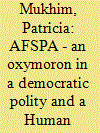

|
|
|
|
|
| Publication |
2013.
|
| Summary/Abstract |
The Armed Forces Special Powers Act (AFSPA) dates back to 1958
when it was passed by the Indian Parliament to quell the Naga rebellion
in a so-called disturbed area. Later it was extended to the states
of Assam, Manipur, Tripura, parts of Meghalaya and Arunachal Pradesh
and later to Jammu and Kashmir in 1990. This Act is a legacy of a
colonial power. The Armed Forces (Special Powers) Ordinance, 1942,
was used by the British to quell dissent during the Second World War.
But even before that it was used as an instrument of repression which
led to the Jallianwala Bagh massacre. It is ironic that a free country
would be waging a war against its own people using all forms of
brutality to secure the nation-building agenda of the State. Why else
would you use the military for an internal rebellion?
|
|
|
|
|
|
|
|
|
|
|
|
|
|
|
|
| 2 |
ID:
096925
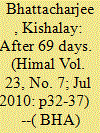

|
|
|
| 3 |
ID:
167702


|
|
|
|
|
| Publication |
New Delhi, Sage Publications India Pvt Ltd, 2015.
|
| Description |
xiv, 430p.: tables, figureshbk
|
| Standard Number |
9789351500766
|
|
|
|
|
|
|
|
|
|
|
|
Copies: C:1/I:0,R:0,Q:0
Circulation
| Accession# | Call# | Current Location | Status | Policy | Location |
| 059709 | 303.660954/CHA 059709 | Main | On Shelf | General | |
|
|
|
|
| 4 |
ID:
141777
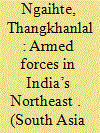

|
|
|
|
|
| Summary/Abstract |
More than 60 years of de facto military rule through the Armed Forces (Special Powers) Act (AFSPA) 1958 in India’s northeast has engendered neither stability nor peace. Problems regarding the impunity of violence and crime, official corruption and the virtual collapse of the rule of law continue, but the Act remains in operation. This article attempts to reframe the debates on the AFSPA in terms of its necessity by turning the necessity argument on its head and arguing that the secessionist insurgencies which were originally used to justify the Act have actually long ceased to exist. Since the principle of existential necessity that provided a fig leaf to the Act no longer applies, its continued application needs to be re-examined. It is further argued that the Indian military’s increasing clout in internal security policy-making may have grave implications for Indian democracy itself, with negative impacts on the rule of law and in relation to safe inclusion strategies for India’s northeast.
|
|
|
|
|
|
|
|
|
|
|
|
|
|
|
|
| 5 |
ID:
122443
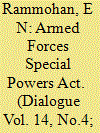

|
|
|
|
|
| Publication |
2013.
|
| Summary/Abstract |
On the 11
th
of July 2004, the personnel of the Assam Rifles picked up a
young woman from her house in Thoubal district at about 2300 hours.
Her house was searched but nothing was found. The Assam Rifles
personnel then arrested her and left after leaving an arrest memo stating
that they had not found anything incriminating. The next morning her
body was found on a nearby hillock with several bullet injuries around
her waist and abdomen. The local people who found her body naturally
thought that she had been raped. This was followed by the extraordinary
spectacle of a group of middle aged and elderly women leading a
march to the gate of the Assam Rifles and disrobing themselves
demanding that they should be raped. The valley then exploded in a
violent agitation that lasted more than a month. Regrettably the reaction
from the Centre was most unsympathetic. The statements made by
some senior officials were particularly insensitive. One stated that the
lady, Thangjom Manorama was a PLA cadre and she was an explosives
expert and several security personnel had been hurt and killed by her
explosive devices. This seemed to imply that her killing was justified.
|
|
|
|
|
|
|
|
|
|
|
|
|
|
|
|
| 6 |
ID:
118871
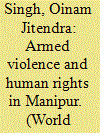

|
|
|
| 7 |
ID:
095701
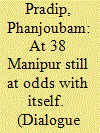

|
|
|
| 8 |
ID:
145816
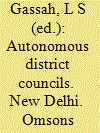

|
|
|
|
|
| Publication |
New Delhi, Omsons Publications, 1997.
|
| Description |
xi, 350p.hbk
|
| Standard Number |
8171171540
|
|
|
|
|
|
|
|
|
|
|
|
Copies: C:1/I:0,R:0,Q:0
Circulation
| Accession# | Call# | Current Location | Status | Policy | Location |
| 058702 | 352.264/GAS 058702 | Main | On Shelf | General | |
|
|
|
|
| 9 |
ID:
132133
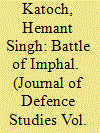

|
|
|
|
|
| Publication |
2014.
|
| Summary/Abstract |
The year 2014 is the 70th anniversary of the Battle of Imphal. To mark the occasion, this article looks at who fought it; how and where the fighting unfolded in Manipur; how it was a battle fought in the air as well; and the link with the INA and the Chindits. It also notes the many reminders of the Second World War in Manipur today and concludes with a brief overview of the state's overall experience of the war. The article aims, in effect, to introduce the reader to the Battle of Imphal, an extraordinary event in India's history that has received little to no attention till date.
|
|
|
|
|
|
|
|
|
|
|
|
|
|
|
|
| 10 |
ID:
112011
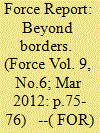

|
|
|
| 11 |
ID:
096926


|
|
|
| 12 |
ID:
139469
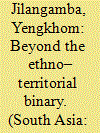

|
|
|
|
|
| Summary/Abstract |
The binary of the hills and the valley is a central theme in understanding the Northeast of India. Although the multiplicity of ‘ethnic’ groups that inhabit both the valley and the hills makes such a generalisation difficult in places like Manipur, the distinctiveness of the two groups is stressed both in everyday and scholarly articulations. Notwithstanding the popularity and power of the hill–valley binary, this article critically engages with various ‘theories’ that have been put forward on this issue and confronts their foundational claims. The intent of the paper is to argue that this binary of hill and valley is not a constructive category either historically or in the contemporary. By looking at the colonial classification between hill and valley, and the popularity of James C. Scott's recent work, I argue that there are multiple strategies adopted to maintain this binary with major implications for politics and society in Manipur and beyond.
|
|
|
|
|
|
|
|
|
|
|
|
|
|
|
|
| 13 |
ID:
090560
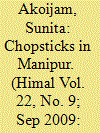

|
|
|
|
|
| Publication |
2009.
|
| Summary/Abstract |
In September 2000, a separatist group known as the Revolutionary People's Front banned the screening of Hindi films in the state, along with the distribution of all Hindi satellite channels. Terming Hindi films to be a form of cultural imperialism, the group said that Bollywood was undermining the culture of Manipur. Soon there was no trace of Hindi films, television serials, song sequences or even songs on radio stations in Manipur. Except for the government-controlled Doordarshan, all satellite channels broadcasting Hindi films and Hindi serials quickly disappeared.
|
|
|
|
|
|
|
|
|
|
|
|
|
|
|
|
| 14 |
ID:
146130
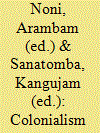

|
|
|
|
|
| Edition |
South Asia ed.
|
| Publication |
Oxon, Routledge, 2016.
|
| Description |
xv, 263p.hbk
|
| Standard Number |
9781138666702
|
|
|
|
|
|
|
|
|
|
|
|
Copies: C:1/I:0,R:0,Q:0
Circulation
| Accession# | Call# | Current Location | Status | Policy | Location |
| 058728 | 325.305417/NON 058728 | Main | On Shelf | General | |
|
|
|
|
| 15 |
ID:
108213
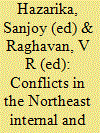

|
|
|
|
|
| Publication |
New Delhi, Vij Books, 2011.
|
| Description |
xi, 116p.
|
| Standard Number |
9789381411124, hbk
|
|
|
|
|
|
|
|
|
|
|
|
Copies: C:1/I:0,R:0,Q:0
Circulation
| Accession# | Call# | Current Location | Status | Policy | Location |
| 056315 | 303.690954/HAZ 056315 | Main | On Shelf | General | |
|
|
|
|
| 16 |
ID:
117167


|
|
|
| 17 |
ID:
118482
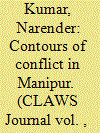

|
|
|
| 18 |
ID:
158094
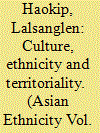

|
|
|
|
|
| Summary/Abstract |
Creative literature and audio-visuals provide alternative sources to archival documents for understanding the cultural history of land. This paper is a small beginning in using creative sources in different languages of Manipur. My analysis suggests that the association between land and ethnicity is a recent phenomenon. In the late 1950s and the 1960s, creative artists represented land as aesthetic symbol for universal emotions. In the 1970s, land was de-linked from political imagination and appeared in the form of leikai (residential address). The 1980s registered the emergence of complex social forces such as ethnic nationalism and a romanticised folk culture. The most remarkable development was the exclusive use of land as a symbol of discrete identities and ethnic homelands. Whereas the ethnic gulf widened between the meiteis of the valley and the tribals of the hill areas, the struggle between the hill tribes intensified in the 1990s.
|
|
|
|
|
|
|
|
|
|
|
|
|
|
|
|
| 19 |
ID:
157021
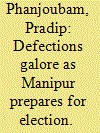

|
|
|
| 20 |
ID:
181339
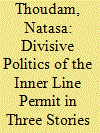

|
|
|
|
|
| Summary/Abstract |
In the context of the Citizenship (Amendment) Act, 2019, and the National Register of Citizens in Assam, this paper interrogates the xenophobic dimensions of Meitei nationalism that translated into a demand for the implementation of the Inner Line Permit (ILP) regime in Manipur in India’s Northeast. The ILP was extended to Manipur in 2019, regulating the entry of ‘outsiders’. Moreover, the recent pandemic has also visibilised the figure of a migrant worker. This paper, however, goes back several years earlier to examine literary representations of the anti-migrant ILP demand. It also highlights its gendered aspect by looking at three texts by ‘dominant’ Meitei women: Ngaseppam Nalini (Nee) Devi’s ‘Mukti’ (2002), Huirongbam Benubala’s ‘Blockade’ (2000) and Kshetrimayum Subadani’s ‘The Heat and the Agony’ (2007). Drawing on theorisations by Anne McClintock and Rosemary Marangoly George, and focussing on the figure of the migrant worker, these stories open up the question of belonging beyond the scope of the nation.
|
|
|
|
|
|
|
|
|
|
|
|
|
|
|
|